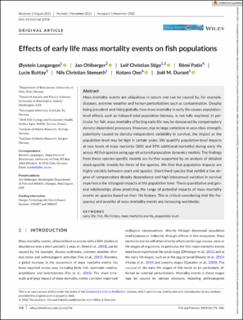| dc.contributor.author | Langangen, Øystein Ole Gahr | |
| dc.contributor.author | Ohlberger, Jan Philipp | |
| dc.contributor.author | Stige, Leif Christian | |
| dc.contributor.author | Patin, Rémi | |
| dc.contributor.author | Buttay, Lucie | |
| dc.contributor.author | Stenseth, Nils Christian | |
| dc.contributor.author | Ono, Kotaro | |
| dc.contributor.author | Durant, Joël | |
| dc.date.accessioned | 2023-01-10T12:54:01Z | |
| dc.date.available | 2023-01-10T12:54:01Z | |
| dc.date.created | 2022-12-14T12:39:40Z | |
| dc.date.issued | 2022 | |
| dc.identifier.citation | Fish and Fisheries. 2022, 24 (1), 176-186. | en_US |
| dc.identifier.issn | 1467-2960 | |
| dc.identifier.uri | https://hdl.handle.net/11250/3042344 | |
| dc.description.abstract | Mass mortality events are ubiquitous in nature and can be caused by, for example, diseases, extreme weather and human perturbations such as contamination. Despite being prevalent and rising globally, how mass mortality in early life causes population-level effects such as reduced total population biomass, is not fully explored. In particular for fish, mass mortality affecting early life may be dampened by compensatory density-dependent processes. However, due to large variations in year-class strength, potentially caused by density-independent variability in survival, the impact at the population level may be high in certain years. We quantify population-level impacts at two levels of mass mortality (50% and 99% additional mortality) during early life across 40 fish species using age-structured population dynamics models. The findings from these species-specific models are further supported by an analysis of detailed stock-specific models for three of the species. We find that population impacts are highly variable between years and species. Short-lived species that exhibit a low degree of compensatory density dependence and high interannual variation in survival experience the strongest impacts at the population level. These quantitative and general relationships allow predicting the range of potential impacts of mass mortality events on species based on their life history. This is critical considering that the frequency and severity of mass mortality events are increasing worldwide. | en_US |
| dc.language.iso | eng | en_US |
| dc.title | Effects of early life mass mortality events on fish populations | en_US |
| dc.title.alternative | Effects of early life mass mortality events on fish populations | en_US |
| dc.type | Peer reviewed | en_US |
| dc.type | Journal article | en_US |
| dc.description.version | publishedVersion | en_US |
| dc.source.pagenumber | 176-186 | en_US |
| dc.source.volume | 24 | en_US |
| dc.source.journal | Fish and Fisheries | en_US |
| dc.source.issue | 1 | en_US |
| dc.identifier.doi | 10.1111/faf.12718 | |
| dc.identifier.cristin | 2093057 | |
| dc.relation.project | Norges forskningsråd: 280467 | en_US |
| dc.relation.project | Norges forskningsråd: 255487 | en_US |
| cristin.ispublished | true | |
| cristin.fulltext | original | |
| cristin.fulltext | original | |
| cristin.qualitycode | 2 | |
